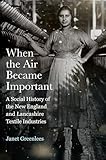When the Air Became Important : A Social History of the New England and Lancashire Textile Industries / Janet Greenlees.
Material type: TextSeries: Critical Issues in Health and MedicinePublisher: New Brunswick, NJ : Rutgers University Press, [2019]Copyright date: ©2019Description: 1 online resource (220 p.) : 7 b-w halftonesContent type:
TextSeries: Critical Issues in Health and MedicinePublisher: New Brunswick, NJ : Rutgers University Press, [2019]Copyright date: ©2019Description: 1 online resource (220 p.) : 7 b-w halftonesContent type: - 9780813587967
- 9780813587981
- 331.3/877094276 23
- online - DeGruyter
- Issued also in print.
| Item type | Current library | Call number | URL | Status | Notes | Barcode | |
|---|---|---|---|---|---|---|---|
 eBook
eBook
|
Biblioteca "Angelicum" Pont. Univ. S.Tommaso d'Aquino Nuvola online | online - DeGruyter (Browse shelf(Opens below)) | Online access | Not for loan (Accesso limitato) | Accesso per gli utenti autorizzati / Access for authorized users | (dgr)9780813587981 |
Browsing Biblioteca "Angelicum" Pont. Univ. S.Tommaso d'Aquino shelves, Shelving location: Nuvola online Close shelf browser (Hides shelf browser)
Frontmatter -- Contents -- Abbreviations -- Chapter 1. Introduction: When Does the Air in the Workplace Become Important? -- Chapter 2. Textile Towns and Mill Environments -- Chapter 3. Tuberculosis in the Factory -- Chapter 4. "I Used to Feel Ill with It": Heat, Humidity, and Fatigue -- Chapter 5. Dust: A New Socio-Environmental Relationship -- Chapter 6. "The Noise Were Horrendous": The Ignored Industrial Hazard -- Chapter 7. Conclusion: When Does the Air Become Important? -- Acknowledgments -- Notes -- Bibliography -- Index -- About the Author
restricted access online access with authorization star
http://purl.org/coar/access_right/c_16ec
In When the Air Became Important, medical historian Janet Greenlees examines the working environments of the heartlands of the British and American cotton textile industries from the nineteenth to the late twentieth centuries. Greenlees contends that the air quality within these pioneering workplaces was a key contributor to the health of the wider communities of which they were a part. Such enclosed environments, where large numbers of people labored in close quarters, were ideal settings for the rapid spread of diseases including tuberculosis, bronchitis and pneumonia. When workers left the factories for home, these diseases were transmitted throughout the local population, yet operatives also brought diseases into the factory. Other aerial hazards common to both the community and workplace included poor ventilation and noise. Emphasizing the importance of the peculiarities of place as well as employers' balance of workers' health against manufacturing needs, Greenlees's pioneering book sheds light on the roots of contemporary environmentalism and occupational health reform. Her work highlights the complicated relationships among local business, local and national politics of health, and community priorities.
Issued also in print.
Mode of access: Internet via World Wide Web.
In English.
Description based on online resource; title from PDF title page (publisher's Web site, viewed 21. Jun 2021)









